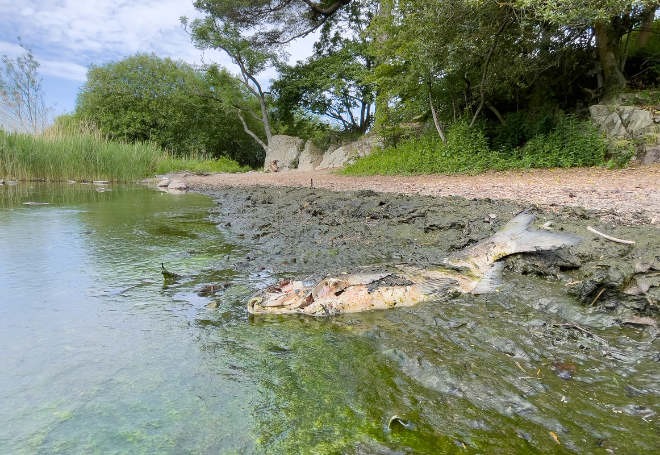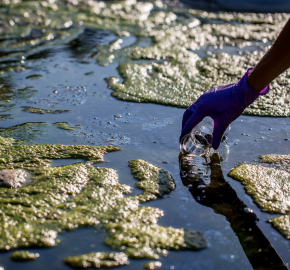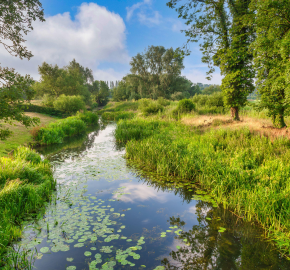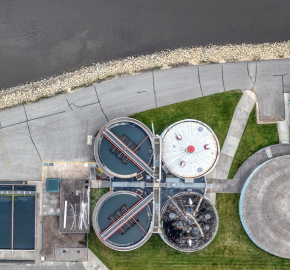We need a cautious and data-savvy approach to assessing long-term trends in the ecological status of our rivers

Environmental data is vital in our fight to reverse nature’s decline, but interpreting it isn’t always straightforward. The aim of collecting monitoring data (e.g. of fish or invertebrate populations) is to try and understand the changes we are currently experiencing in nature and how we might better protect and restore the natural world for generations to come.
However, it is important to remember that the decisions we make and the processes that we use when collecting and analysing biological data will have a large influence on the conclusions that are ultimately drawn.
Our freshwater habitats and the life that they nurture are in trouble. It may be true that many rivers are in better condition today than in the industrial revolution. But today’s narrative is a seemingly constant stream (forgive the pun) of concerning reports regarding the record numbers of sewage spills, widespread agricultural impacts, threats posed by existing and novel chemicals, and climate change ramifications for freshwater biomes.
Combined with the apparent lack of political will to hold to existing commitments to protect rivers, let alone the enforcement of the environmental protections that we need, it seems an untenable position to be arguing that all is well beneath the surface.

Algal bloom in the Lake Windermere catchment.
Yet, some recent academic studies assessing trends from long-term biological datasets, such as the ChemPop Project from the Centre for Ecology and Hydrology (CEH), have suggested that all is not as bad as it seems and pointed to improvements in the past few decades.
We first wrote about the need to be cautious with family-level assessments of freshwater invertebrate biodiversity in October 2023 (linked here). This was in response to the Qu et al (2023) paper on invertebrate family trends, summarising our key themes of concern regarding this research. The project has since produced a paper regarding long-term trends for fish populations in England (Nunn et al, 2025). Again, we have a number of concerns with this study and some of the decisions regarding data handling and interpretation.
Shortly after, we were contacted by Dr Martin Wilkes, an ecologist from the University of Essex, who has a background in data science and an interest in how the data we collect from the natural world can be most effectively used to understand biodiversity changes.
Martin has recently authored peer-reviewed research regarding the uncertainty that can be created depending on how we handle and analyse long-term biological monitoring datasets. This blog summarises some of his key concerns regarding the handling of data in studies such as ChemPop, and data-savvy solutions for how we can better use long-term datasets for the future benefit of our environment.
In the content that follows, Martin takes a deep dive into the challenges of data collection and analysis, and offers a word of caution when assessing long-term trends in the ecological health of our rivers.
Key concerns with studies such as ChemPop
Long-term dataset collection and management processes, as well as simplistic metric choices, create uncertainty in trend assessments. Our research shows that, after accounting for operational changes and focusing on more robust biodiversity metrics, the overwhelmingly positive trends presented by ChemPop are replaced by a much more nuanced picture.
A focus on richness (diversity) in the analysis of biodiversity trends leads to outcomes that are sensitive to imperfect detection, i.e. the tendency for all biological monitoring to miss some taxa (e.g. species or families) present at the time of sampling.
For reasons related to operational changes, ecological processes, and statistical factors, a simplistic count of all taxa identified in a sample does not represent the biodiversity of a water body in a way that is comparable over time. For example, we know that macroinvertebrate monitoring has generally detected a larger fraction of biodiversity over time, but also that the rates of detection have fluctuated (e.g. generally increasing but temporarily declining in 2013). Similar processes have affected fish, macrophyte (plant) and diatom (algae) monitoring.
The ChemPop trend models are therefore confounded because a change in the richness metric cannot be interpreted as a real change in the underlying biodiversity. Taking a more data-savvy approach, it is clear that many fish and macroinvertebrate populations of conservation interest are declining in abundance, most invasive non-native populations are expanding rapidly, and the majority of macrophyte population distributions are contracting (Wilkes et al., 2025, p.15).

SmartRivers volunteers sample the abundance and diversity of aquatic invertebrates as indicators of water quality.
Transparency is essential to understand the biases in long term monitoring datasets.
Without transparently quantifying biases in biological data sets, we do not know how representative reported trends and species-environment relationships are of the national picture.
There is a lack of transparency on the biases present in the ChemPop data. This has important implications for:
- The interpretation of past temporal trends.
- The robustness of reported species-environment relationships, such as the pre-eminence of copper and zinc in suppressing macroinvertebrate richness (Johnson et al., 2025).
- How future observations are benchmarked under any future framework for assessing ecological status.
We know that Environment Agency monitoring has historically been biased towards larger rivers with urbanised catchments (Wilkes et al., 2025, p.5). We also know that these biases become more severe as the historical monitoring data are filtered to derive longer, more complete timeseries with matched flow and water quality data – as undertaken in the ChemPop project.
This is particularly significant going forwards under the recently introduced River Surveillance Network, which corrects biases in the historical sampling network (see below).
Flawed historical reference conditions can only lead to greater uncertainty
By continuing to discount changing thermal and hydrological conditions, an overly simplistic approach to setting reference conditions would lead to an increasingly confounded view of ecological status.
It is clear that taking a more cautious and data-savvy approach is key to understanding historical trends in river biodiversity. But even more important is how we harness the fantastic (albeit messy) data available to underpin a better ecological assessment framework in the future.
Any future assessment framework that benchmarks observations against historical reference conditions would fail to address a major flaw in the Water Framework Directive (WFD) system. UK river systems are changing fast – on average, river waters are warming by 0.3 °C per decade and extreme flood and drought risk are increasing in most regions.
Temperature and flow are the “master variables” of river ecosystems. Hence, these changes are causing biodiversity shifts that are independent of stressors such as heavy metal pollution, nutrient enrichment and habitat modification, in ways that are not reflected in the WFD system.
Furthermore, a dependence on severely biased historical monitoring to benchmark ecological status (see above), combined with application to data generated on the less biased River Surveillance Network, risks systematically misrepresenting the reference condition for many water bodies.
Our evidence and recommendations
To overcome these challenges, we propose the following (with evidence):
1. Appropriate biodiversity measures and statistical models provide more reliable future assessments
Our ability to not only classify ecological status but also identify reasons for not achieving good status is critical to informing future management. A pressure-agnostic approach would provide no such management insights.
We advocate for a focus on species population abundance (for fish and invertebrates) and occupancy (for macrophytes and diatoms, due to the nature of the data) using appropriate statistical models that account for:
- Imperfect detection including the impacts of operational changes over time
- Systematic biases in the data
- Shifting thermal and hydrological conditions.
Our recently published paper (Wilkes et al., 2025) shows that data filtering procedures and statistical models of the type applied in the ChemPop project lead to biased trend estimates and substantial uncertainty in reported trends.
Providing an example based on 188 of the macroinvertebrate taxa listed in the species abundance target, another recent contribution (Wilkes et al., 2024) goes on to show how the historical data can be modelled to provide critical insights for managers by explicitly linking status classification with the actions necessary to deliver good ecological status in the future (see below).
2. Plan for a future with healthier rivers rather than basing expectations on current conditions
Base reference conditions upon biodiversity expected if targets for the water environment were met.
The model of Wilkes et al. (2024) provides a blueprint for how this predictive approach can be implemented. We show how:
- Reductions in phosphorus and nitrate concentrations and the removal of river channel modifications are priority actions for most water bodies
- A catchment-specific approach to setting targets for the water environment significantly reduces the cost of intervention
- An alternative “target-driven” approach can provide a more realistic benchmark for ecological status classification
Whilst limited to a subset of stressors, we are actively developing our framework with Environment Agency partners to include more robust measures of abstraction pressure, sediment pollution, harmful metals, and other adverse ecological impacts of sewage discharges. This will enable us to model the full range of Defra’s statutory and non-statutory targets for the water environment (e.g., reduce phosphorus loadings from treated wastewater by 80% by 2038 against a 2020 baseline).
Being cautious and data-savvy with long-term data sets will help us to better understand and protect our rivers in the present and future.
We started this blog with the statement that biological data is messy. By necessity the decisions made to organise and analyse long-term monitoring datasets are incredibly nuanced and complex and ultimately will have a large influence on the eventual conclusions that are drawn. This blog succinctly highlights the challenges faced in this regard and sets out evidence-led recommendations for how we can better use these powerful long-term monitoring datasets for the benefit of our rivers in the future.
To find out more about the research mentioned in this blog please see:
Dr Wilkes’ Research
Wilkes, M.A., Mckenzie, M., Johnson, A., Hassall, C., Kelly, M., Willby, N. & Brown, L.E. (2025). Revealing hidden sources of uncertainty in biodiversity trend assessments. Ecography, e07441.
Wilkes, M.A., Mungee, M., Naura, M., Bell, V.A. & Brown, L.E. (2024). Predicting nature recovery for river restoration planning and ecological assessment: A case study from England, 1991–2042. River Research and Applications, 41(1), 68-81.
UKCEH Research
Qu, Y. et al (2023). Significant improvement in freshwater invertebrate biodiversity in all types of English rivers over the past 30 years. Science of The Total Environment, 167144.
Nunn, A. et al (2025). Responses of fish to nationwide improvements in the water quality of a densely populated and heavily modified country over four decades. Water Research, 274, 123163.
Johnson, A.C., Sadykova, D., Qu, Y., Keller, V.D., Bachiller-Jareno, N., Jurgens, M.D., Eastman, M., Edwards, F., Rizzo, C., Scarlett, P.M. & Sumpter, J.P. (2025). Zinc and copper have the greatest relative importance for river macroinvertebrate richness at a national scale. Environmental Science & Technology, 59(8), 4068-4079.



